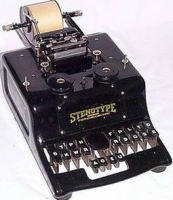








A stenotype, stenotype machine, shorthand machine or steno writer is a specialized chorded keyboard or typewriter used by stenographers for shorthand use. In order to pass the United States Registered Professional Reporter test, a trained court reporter or closed captioner must write speeds of approximately 180, 200, and 225 words per minute (wpm) at very high accuracy in the categories of literary, jury charge, and testimony, respectively.Some stenographers can reach 300 words per minute. The Web site of the California Official Court Reporters Association gives the official record for American English as 375 wpm.
The stenotype keyboard has far fewer keys than a conventional alphanumeric keyboard. Multiple keys are pressed simultaneously (known as "chording" or "stroking") to spell out whole syllables, words, and phrases with a single hand motion. This system makes real-time transcription practical for court reporting and live closed captioning. Because the keyboard does not contain all the letters of the English alphabet, letter combinations are substituted for the missing letters. There are several schools of thought on how to record various sounds, such as the StenEd, Phoenix, and Magnum Steno theories.
The first shorthand machine (the word "stenotype" was not used for another 80 years or more) punched a paper strip and was built in 1830 by Karl Drais, a German inventor.The first machine was made in 1863 by the Italian Antonio Zucco and was in actual use since 1880 in the Italian Senate. An American shorthand machine was patented in 1879 by Miles M. Bartholomew. A French version was created by Marc Grandjean in 1909. The direct ancestor of today's stenotype was created by Ward Stone Ireland about 1913, and the word "stenotype" was applied to his machine and its descendants sometime thereafter.
Most modern stenotype keyboards have more in common with computers than they do with typewriters or QWERTY computer keyboards. Most contain microprocessors, and many allow sensitivity adjustments for each individual key. They translate stenotype to English internally using user-specific dictionaries, and most have small display screens. They typically store a full day's work in non-volatile memory of some type, such as an SD Card. These factors influence the price, along with economies of scale, as there are only a few thousand stenotype keyboards sold each year. As of October 2013, student models, such as a Wave writer, sell for about US$1,500 and top-end models sell for approximately US$5,000. Machines that are 10 to 15 years old still resell for upwards of $350.